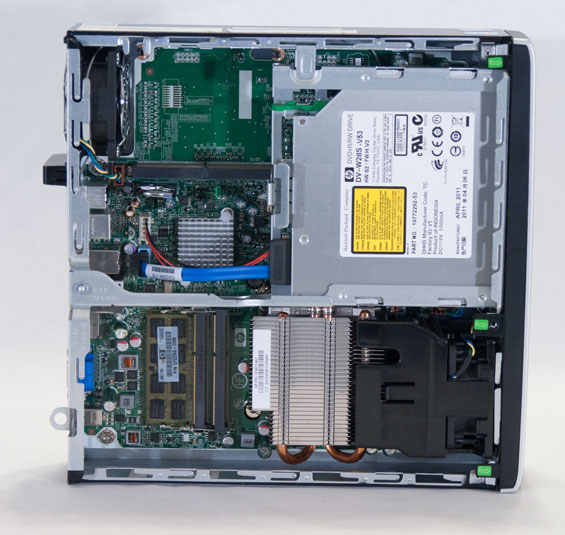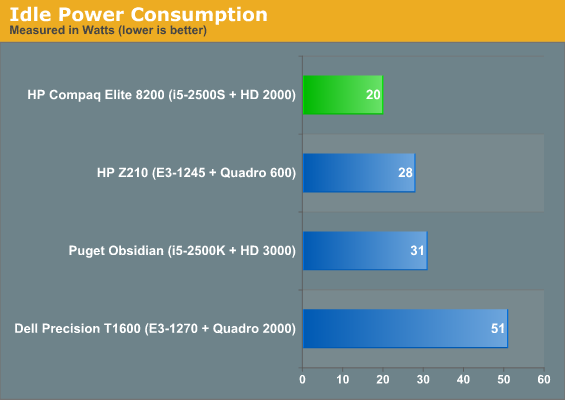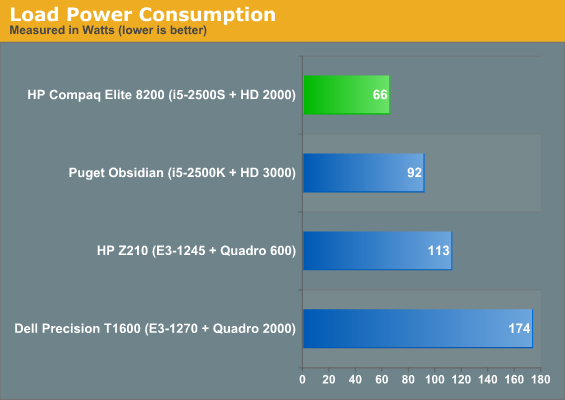HP Compaq 8200 Elite Ultra-Slim: The Littlest Desktop
by Dustin Sklavos on September 29, 2011 10:40 AM EST- Posted in
- Systems
- IT Computing
- HP
- SFF
- Enterprise
Build, Noise, Heat, and Power Consumption
Once again I have to state that I'm a big fan of how enterprise-class computers are built, specifically in regards to internal layout. Because these machines are designed to be easily serviced should the need arise, there are really quite a lot of intelligent ideas that go into how they're built that make me wonder why we don't see them more often on the consumer side. Take a look inside the wonderfully small HP Compaq 8200 Elite Ultra-Slim.

Everything is in its right place and extremely easy to service. Due to the smaller form factor, HP opts for mainly notebook parts inside the 8200 outside of the 65-watt processor. There's a substantial heatsink complete with copper heatpipes covering the processor, and a fan from the front channels air straight through it and out of the back of the case, cooling the memory in the process.
When I opened the 8200 the first time I was surprised to see the relatively large empty space in the top left corner; that MXM slot is actually there in case the system is custom ordered with a graphics upgrade, which can be cooled by the second small fan. The catch as noted earlier is that the only graphics upgrade available is an AMD Radeon HD 5450. Given the nature of this desktop, we can't say that upgrade is really worth it.

Considering the low power components of the 8200, it should come as no surprise that the system runs quietly and stays reasonably cool. The CPU temperatures aren't stellar (though they're still better than most notebooks we test), but this is also a very small enclosure, and HP has largely erred on the side of silence rather than performance. Since Sandy Bridge is already a cool-running architecture to begin with, this winds up being the right trade. Air circulation within the chassis also seems to be good enough to keep the 2.5" Western Digital Scorpio Black running cool.


Other than pure size, power consumption winds up being the 8200's trump card. With load power of just 66 watts, it's not hard to see why a business might want to deploy several of these for users who don't need extremely high-powered hardware. Idling at the desktop, it consumes a miserly 20 watts.














41 Comments
View All Comments
kritschg - Thursday, September 29, 2011 - link
My company looked at both the 8200 and the 6005 and went with the 6005 with an ATHLON II X4 610E and a 64GB SSD. We have 1200+ call center PCs that are on 24x7x365.Average power draw was around 51W full load, 21 Idle. We also looked at Dell and they were 65/53 load/idle for their smallest enterprise desktop.
Another huge benefit is the dual fan design. The system will run under full load with only one fan, temp goes up 5 degrees. External power supply is also helpful, 3 minute replacement.
When a thin client won’t work add an SSD and a low power CPU and this is the ultimate call center PC.
Don't forget the cable lock, these little guys will grow legs if they're not locked down.
albiglan - Thursday, September 29, 2011 - link
So.. the power supply is external. Not that I don't know what that looks like :-) But a pict showing relative dimensions would be a lovely addition. Nice review of an interesting piece of HW.Shaocaholica - Thursday, September 29, 2011 - link
I like the slim Optiplex better. About the same size but has 4 dimm slots and full size PCIe graphics.Blaze-Senpai - Thursday, September 29, 2011 - link
If they make these available to consumers directly I wouldn't mind too much. That onsite warranty would make a lot of people I know happy. Unless people actually want super flashy looking mess still :Petamin - Thursday, September 29, 2011 - link
Just a suggestion. In the future, do you mind putting up a photo of the box next to some kind of reference object like a coke can? When I read "Get a load of that" I was a bit lost until I saw the optical drive as a reference (but it is still hard to estimate the depth of the box). Would also like to see a photo of the AC adapter too in this case. Other than that, nicely done.Pessimism - Friday, September 30, 2011 - link
Seconded. A pop can for reference would be great for future photos as well as a shot of all associated bricks and dongles.ally003 - Friday, September 30, 2011 - link
We have hundreds of the previous 8000 USD machines, and they are ideal. Real world pricing is different from RRP, we are being offered the 8200 with 4GB and i5 for £345 with a 3 year warranty direct from HP on our contract. I can't see that being topped, and no way can I see an Apple coming close for specification, quality or support for £345. A company like Apple won't give a shit about what your needs or requirements are, it's the Apple way or the highway and that is why they have utterly failed in enterprise and will continue to do so.Lack of USB 3.0 is a non-issue for their intended market. The USB is only ever likely to be used for mice, keyboards, the odd memory stick or scanner/printer. They have lots of options including the quick release bracket that makes them mountable on any surface or even on the back of a screen.
When you are deploying thousands of machines for basic office tasks, this is exactly what you want, end of story.
ultrabay - Tuesday, October 4, 2011 - link
the first time I read that, I read "$8000 machines were ideal"whelp.
DanaG - Wednesday, October 5, 2011 - link
Yeah, that should be "USDT". Makes it clearer, (though it essentially says "DeskTop" with a capital 'T').pervisanathema - Tuesday, October 4, 2011 - link
This used to be a site for the PC geeks. Now it has been reduced to reviewing OEM PCs that their old target audience would sneer at. :(